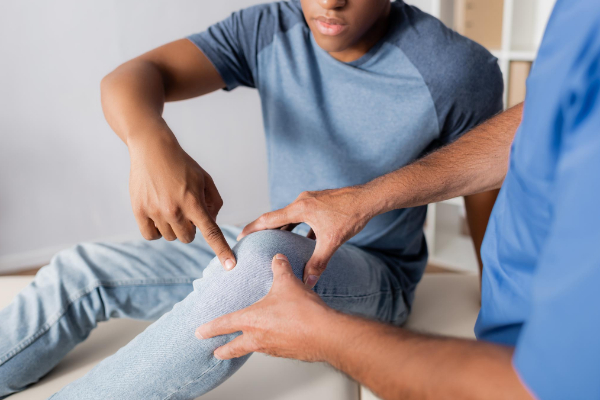Meniscus Tear Surgery
A meniscus tear is one of the most common knee injuries, particularly in athletes and active individuals. The meniscus is a piece of cartilage that cushions the knee joint and helps absorb shock. When torn, it can cause pain, swelling, and instability, often requiring surgery if symptoms persist.
This page explains the key facts about meniscus tear surgery, including causes, symptoms, diagnosis, treatment options, surgical techniques, and recovery.

What is the Meniscus?
The knee has two menisci – medial (inner side) and lateral (outer side). These C-shaped discs act as shock absorbers between the thighbone (femur) and shinbone (tibia).
When the meniscus is torn, it can interfere with the smooth movement of the knee, causing pain and limiting activity.
Causes of Meniscus Tears
A meniscus tear often happens when:
- Twisting or pivoting the knee suddenly
- Squatting or kneeling deeply
- Lifting heavy objects awkwardly
- Age-related wear and tear (degenerative meniscus tear)
Common in sports such as football, rugby, netball, and tennis, meniscus injuries can also occur in everyday life.
Symptoms of a Meniscus Tear
Typical signs include:
- Sharp knee pain, particularly when twisting
- Swelling that develops over 24–48 hours
- A “locking” or “catching” sensation in the knee
- Stiffness and reduced range of movement
- Knee instability or giving way
Diagnosis of Meniscus Injuries
A consultant knee surgeon may use:
- Clinical examination (checking joint line tenderness, McMurray’s test)
- MRI scan to confirm the tear and its location
- X-ray to rule out arthritis or fractures
Treatment Options for Meniscus Tears
Non-Surgical Treatment
Some tears can heal without surgery. Management may include:
- Rest, ice, compression, and elevation (RICE)
- Anti-inflammatory medication
- Physiotherapy to strengthen surrounding muscles
This approach is most suitable for small tears or less active patients.
Meniscus Tear Surgery
If symptoms persist or the tear is large, surgery may be recommended. Surgery helps restore knee function, reduce pain, and protect the joint from further damage.
Meniscus Tear Surgery Explained
Before
- MRI scan to identify the type and size of the tear
- Discussion about surgical options (repair vs removal)
- Pre-operative physiotherapy if required
During
- Performed under a general anaesthetic
- Keyhole (arthroscopic) surgery using small incisions
- Options include:
- Meniscus Repair – stitching the torn cartilage (preferred when possible)
- Partial Meniscectomy – trimming or removing the damaged part of the meniscus
After
- Most patients return home the same day
- Use of crutches for a short period
- Early physiotherapy to restore motion and strength
Recovery After Meniscus Surgery
Short-Term Recovery
- Walking with crutches for a few days up to two weeks
- Gradual return to daily activities
Rehabilitation Timeline
- 0–6 weeks: Reduce swelling and regain range of movement
- 6–12 weeks: Strength training and balance exercises
- 3–6 months: Return to sport or higher-level activities
Recovery time depends on the type of surgery performed. Meniscus repairs take longer to heal compared to partial meniscectomy but preserve more natural knee function in the long term.

Risks and Complications
Although generally safe, meniscus surgery carries potential risks:
- Infection
- Stiffness or reduced range of motion
- Blood clots
- Re-tear of the meniscus
Why Choose Mr Mark Webb for Meniscus Tear Surgery?
When you choose Mr Mark Webb for your meniscus tear surgery, you can expect:
-
An accurate diagnosis and a treatment plan designed around your needs
-
Advanced arthroscopic techniques for the best possible outcome
-
A personalised rehabilitation programme tailored to your recovery goals
-
The highest chance of achieving pain relief and long-term knee stability
Frequently Asked Questions
How will I know if I actually need surgery for my meniscus tear?
You may need surgery if your knee is often swollen, painful, or locking and doesn’t improve with rest or physiotherapy. Surgery is also considered if the tear is large, displaced, or affecting an area with good blood supply, or if conservative treatments have not relieved your symptoms.
What are the types of meniscus surgery, and how do they differ?
There are a few surgical options:
-
Meniscus repair: the torn meniscus is stitched back together so it can heal, usually possible when the tear is in a well-supplied area.
-
Partial meniscectomy: the damaged portion of the meniscus is trimmed away when repair isn’t possible.
-
Meniscus transplantation: in select cases, especially younger patients with severe damage, a donor meniscus may be used.
What will recovery look like, and when can I get back to my normal activities?
Recovery depends on the type of surgery and the size of your tear. After a partial meniscectomy, many people can walk normally very quickly and return to daily activities in a few weeks. After a meniscus repair, healing takes longer and you may need crutches, a brace, and physiotherapy. Full return to sport can take 4–9 months.
What are the risks or complications I should be aware of?
Meniscus surgery is generally safe, but possible risks include infection, bleeding, swelling, or stiffness of the knee joint. There is also a chance the repair may not heal fully or could re-tear. A partial meniscectomy can place more stress on the knee, which may contribute to arthritis in the long term.
How should I prepare for meniscus tear surgery to get the best outcome?
Before surgery, talk to your surgeon about what to expect and complete any recommended medical tests. Strengthening the muscles around your knee, staying active, and preparing your home (such as arranging crutches or reducing the need for stairs) can help make your recovery smoother.

